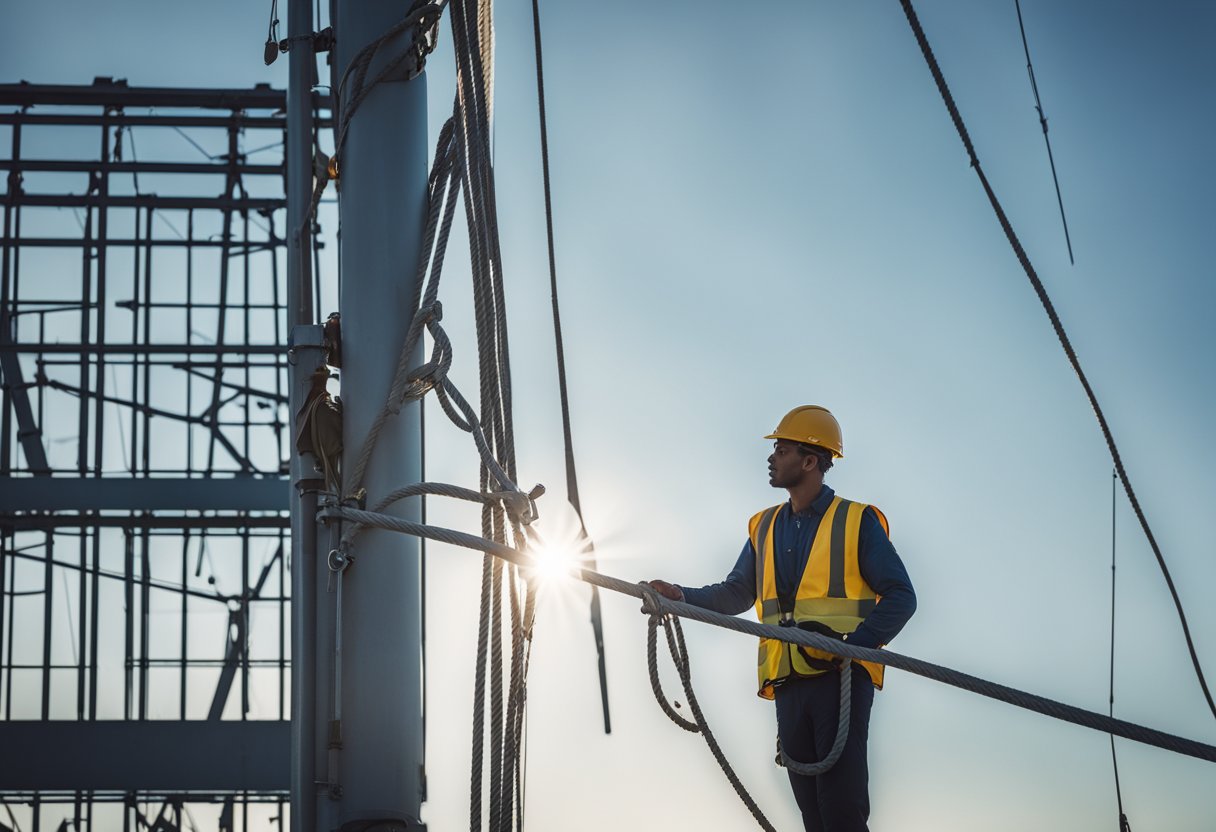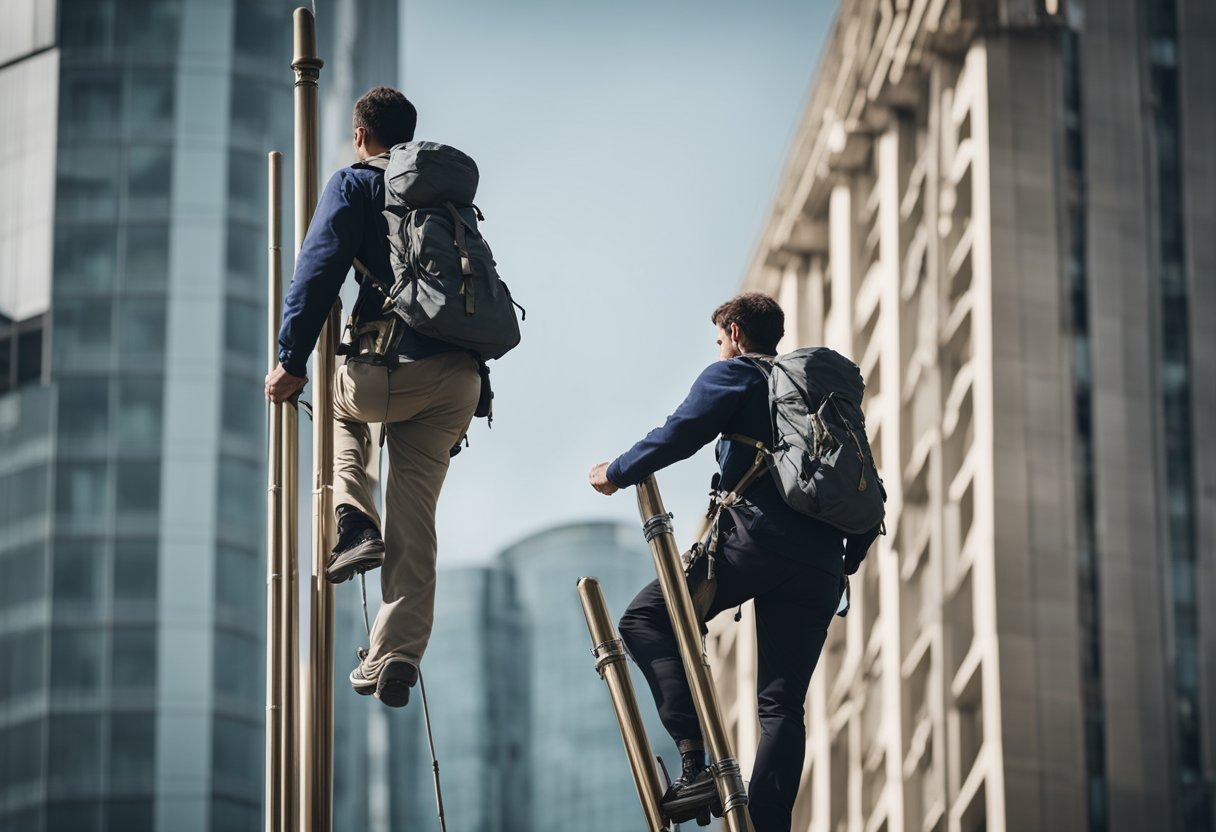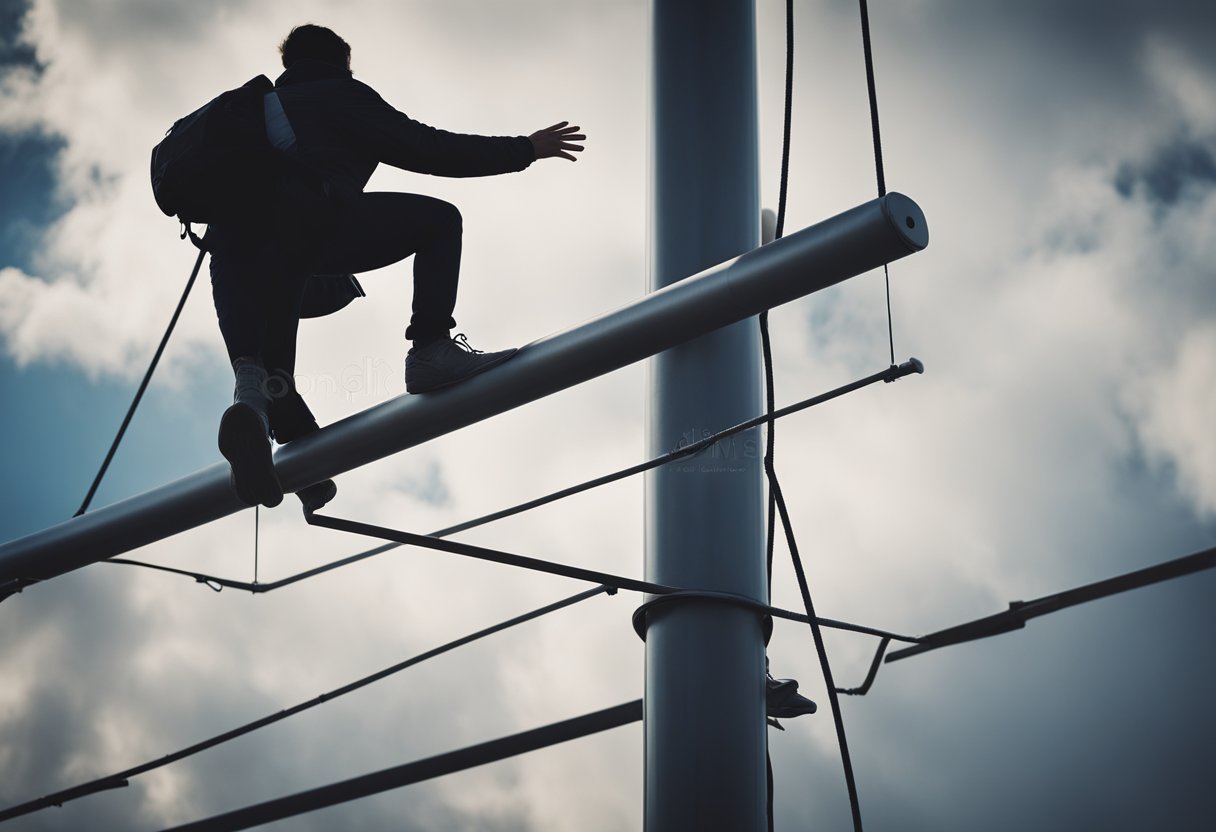Climbing a flagpole may seem like a daunting task, but with the right knowledge and preparation, it can be done safely and efficiently. Whether you’re a professional flagpole climber or just looking to raise the flag at your home, understanding the basics of flagpoles and climbing techniques is essential.
Before you begin climbing, it’s important to prepare yourself and the area around the flagpole. This includes choosing the right ladder, ensuring it’s stable and secure, and wearing appropriate safety gear like a harness and helmet. It’s also important to understand the risks and dangers associated with flagpole climbing and to take necessary precautions to avoid accidents.
In this article, I will guide you through the process of climbing a flagpole, from understanding the basics of flagpoles to choosing the right ladder and climbing techniques. I will also discuss the risks and dangers associated with flagpole climbing and provide tips for maintaining and repairing flagpoles. By the end of this article, you will be equipped with the knowledge and skills necessary to climb a flagpole safely and confidently.
Key Takeaways
- Understanding the basics of flagpoles and climbing techniques is essential for safe and efficient flagpole climbing.
- Proper preparation, including choosing the right ladder and wearing appropriate safety gear, is crucial for avoiding accidents.
- It’s important to understand the risks and dangers associated with flagpole climbing and to take necessary precautions to stay safe.
Understanding the Basics of Flagpoles
https://www.youtube.com/watch?v=Oy2Gg1R_cUc&embed=true
As someone who has climbed many flagpoles, I can tell you that it’s essential to understand the basics of flagpoles before attempting to climb one. Here are some key things to keep in mind:
Materials
Most flagpoles are made of steel, which makes them strong and durable. However, some flagpoles are made of other materials such as aluminum, fiberglass, or wood. It’s important to know what material the flagpole is made of before attempting to climb it.
Height and Diameter
The height and diameter of the flagpole are also important factors to consider. The height of the flagpole can range from a few feet to over 100 feet, while the diameter can range from a few inches to several feet. The taller and wider the flagpole, the more difficult it will be to climb.
Components
Flagpoles consist of several components, including the pole itself, the halyard (rope), the flag, and the cleat. The halyard is used to raise and lower the flag, while the cleat is used to secure the halyard in place. It’s important to inspect each component carefully before attempting to climb the flagpole.
Safety Measures
Before climbing a flagpole, it’s important to take safety measures to ensure a safe ascent and descent. This includes wearing appropriate climbing gear such as a climbing harness, helmet, and gloves. Additionally, it’s crucial to have a spotter on the ground who can assist you and call for help if needed.
By understanding the basics of flagpoles, you can ensure a safe and successful climb. Remember to always prioritize safety and take the necessary precautions before attempting to climb a flagpole.
Preparation for Climbing
https://www.youtube.com/watch?v=cwklu0oUdM0&embed=true
Before attempting to climb a flagpole, it is important to ensure that you have all the necessary equipment and safety gear. First and foremost, you should have a ladder that is tall enough to reach the top of the flagpole. Make sure the ladder is in good condition and has a weight capacity that can accommodate your weight.
To secure a ladder to a flagpole, you can use ladder stabilizers or ladder hooks. Ladder stabilizers are designed to prevent the ladder from slipping or moving while you climb. Ladder hooks, on the other hand, can be attached to the flagpole and provide a secure anchor point for the ladder. When securing a ladder to a flagpole, make sure to follow the manufacturer’s instructions carefully to ensure your safety.
It is also important to wear appropriate safety gear when climbing a flagpole. This includes gloves to protect your hands from rope burns and cuts, and a safety harness to prevent falls. Make sure the safety harness is properly fitted and secured before you start climbing.
In addition to safety gear, flagpoles may have safety features such as safety cages or ladder safety devices. A safety cage is a metal cage that surrounds the ladder and provides additional protection against falls. Ladder safety devices are designed to prevent falls by locking onto the ladder rungs and preventing the ladder from slipping.
Overall, preparation is key when it comes to climbing a flagpole. Make sure you have all the necessary equipment and safety gear, and follow proper safety procedures to ensure a safe and successful climb.
Choosing the Right Ladder
https://www.youtube.com/watch?v=OKCnw9Pz-YY&embed=true
When it comes to climbing a flagpole, choosing the right ladder is crucial for your safety. The type of ladder you choose will depend on the height of the flagpole and the angle at which it is leaning. Here are some types of ladders and their features that you should consider before making your choice:
Monowheel Ladder
A monowheel ladder is a type of ladder that has a wheel at the base. This type of ladder is ideal for flagpoles that are on a flat surface, as it can be easily moved around. It is also stable and can support a lot of weight. However, it is not suitable for flagpoles that are on an uneven surface.
Wedge-Style Ladder
A wedge-style ladder is a type of ladder that has a wedge-shaped base. This type of ladder is ideal for flagpoles that are on an uneven surface, as it can be easily adjusted to fit the angle of the flagpole. It is also stable and can support a lot of weight. However, it is not suitable for flagpoles that are on a flat surface.
Semi-Angle Ladder
A semi-angle ladder is a type of ladder that has a semi-angle base. This type of ladder is ideal for flagpoles that are on a slightly uneven surface, as it can be adjusted to fit the angle of the flagpole. It is also stable and can support a lot of weight. However, it is not suitable for flagpoles that are on a flat surface.
Fixed-Angle Ladder
A fixed-angle ladder is a type of ladder that has a fixed angle base. This type of ladder is ideal for flagpoles that are on a flat surface, as it can be easily leaned against the flagpole. It is also stable and can support a lot of weight. However, it is not suitable for flagpoles that are on an uneven surface.
Ladder Stabilizer
A ladder stabilizer is a device that attaches to the top of the ladder and provides additional stability. This is particularly useful for flagpoles that are on an uneven surface or for people who are not confident in their ability to climb a ladder. A ladder stabilizer can also be used to prevent the ladder from sliding down the flagpole.
In conclusion, choosing the right ladder is crucial for your safety when climbing a flagpole. Consider the height and angle of the flagpole, as well as the surface it is on, before making your choice. Additionally, a ladder stabilizer can provide additional safety and stability.
Climbing Techniques and Safety Measures
https://www.youtube.com/watch?v=mYkbOibYiDE&embed=true
Climbing a flagpole can be an exhilarating experience, but it requires proper technique and safety measures to avoid accidents. Here are some tips to help you climb a flagpole safely and efficiently.
Grip and Positioning
The key to climbing a flagpole is to have a good grip and proper positioning. Start by wrapping your arms around the pole and interlocking your fingers. Your feet should be positioned close together, with your toes pointing towards the pole. This will help you maintain balance and control as you climb.
As you climb, use your legs to push yourself up the pole while maintaining your grip with your arms. Keep your body close to the pole to maintain balance and control. Avoid leaning too far out, as this can cause you to lose your grip and fall.
Descending
Descending a flagpole can be just as challenging as climbing up. To descend safely, start by loosening your grip slightly and sliding your hands down the pole. Use your legs to control your descent, slowly sliding down the pole while maintaining your grip with your hands.
Strength and Practice
Climbing a flagpole requires a certain level of strength and endurance. If you are new to flagpole climbing, start by practicing on a shorter pole or using a pole climbing simulator. This will help you build up your strength and improve your technique before attempting to climb a full-sized flagpole.
Safety Measures
Safety should always be your top priority when climbing a flagpole. Always wear appropriate safety gear, such as a helmet and climbing harness. Make sure the flagpole is in good condition and free from any defects or damage before attempting to climb it.
In conclusion, climbing a flagpole requires proper technique, strength, and safety measures. By following these tips, you can climb a flagpole safely and efficiently.
Using a Professional or a Bucket Truck
https://www.youtube.com/watch?v=b3HafLpbWN8&embed=true
When it comes to climbing a flagpole, there are two main options: using a professional or a bucket truck. Both options have their pros and cons, and it’s important to weigh them carefully before making a decision.
Using a Professional
Hiring a professional flagpole climber is a good option if you are not comfortable climbing the flagpole yourself or if the flagpole is too tall or difficult to access. A professional flagpole climber has the necessary training and equipment to climb the flagpole safely and efficiently.
One advantage of using a professional is that they can inspect the flagpole for any damage or wear and tear while they are up there. They can also make any necessary repairs or replacements, such as replacing missing ropes or pulleys.
However, using a professional can be expensive, and you may need to schedule an appointment in advance. It’s also important to make sure that the professional you hire is licensed and insured.
Using a Bucket Truck
Using a bucket truck is another option for climbing a flagpole. A bucket truck is a vehicle with a hydraulic lift that can extend up to several stories high. This option is best if the flagpole is too tall or difficult to access with a ladder or other climbing equipment.
One advantage of using a bucket truck is that it can save time and effort. You can quickly and easily access the top of the flagpole without having to climb it yourself.
However, using a bucket truck can be expensive, and you may need to rent one if you don’t own one. It’s also important to make sure that the bucket truck is in good condition and that you have the necessary training and safety equipment to operate it safely.
In summary, both using a professional and a bucket truck have their advantages and disadvantages. It’s important to carefully consider your options and choose the one that best fits your needs and budget.
Maintaining and Repairing Flagpoles
Maintaining and repairing a flagpole is important to ensure that it remains in good condition and continues to function properly. Here are some tips on how to maintain and repair flagpoles:
Regular Cleaning
One of the most important aspects of maintaining a flagpole is regular cleaning. Dirt, debris, and bird droppings can accumulate on the pole and its components, which can cause damage over time. Use a soft cloth or sponge to clean the pole and its components with a mild soap solution. Avoid using abrasive cleaners or scrub brushes, which can scratch the surface of the pole.
Lubricate Moving Parts
Flagpoles have moving parts such as pulleys and rings that need to be lubricated regularly. Use a silicone-based lubricant to keep these parts moving smoothly. Avoid using oil-based lubricants, which can attract dirt and debris.
Inspect for Damage
Regular inspections of the flagpole can help identify any damage that needs to be repaired. Check for cracks, dents, or other signs of damage on the pole and its components. If any damage is found, it should be repaired as soon as possible to prevent further damage.
Repair or Replace Broken Parts
If any parts of the flagpole are broken or damaged, they should be repaired or replaced immediately. This includes broken pulleys, rings, or other components. If the flagpole is too tall or difficult to access, consider hiring a professional flagpole climber to make the repairs.
By following these tips, you can ensure that your flagpole remains in good condition and continues to function properly. Regular maintenance and repairs can help extend the life of your flagpole and keep it looking great for years to come.
Understanding the Risks and Dangers
As with any physical activity, climbing a flagpole can be dangerous. It is important to understand the risks involved before attempting to climb a flagpole. Climbing a flagpole can be particularly dangerous because of the height involved. Falling from a great height can result in serious injury or death.
There are several factors to consider when assessing the risks involved in climbing a flagpole. These include the condition of the flagpole, the weather conditions, and the climber’s physical condition and experience level. It is important to inspect the flagpole before climbing to ensure that it is in good condition and free from defects. If the flagpole is damaged or in poor condition, it should not be climbed.
Weather conditions can also play a significant role in the safety of flagpole climbing. Climbing a flagpole in high winds or during a thunderstorm can be extremely dangerous. It is important to check the weather forecast before attempting to climb a flagpole and to avoid climbing in hazardous conditions.
Finally, it is important to consider the climber’s physical condition and experience level. Climbing a flagpole requires strength, agility, and balance. It is important to be in good physical condition and to have experience with climbing before attempting to climb a flagpole.
Overall, climbing a flagpole can be a dangerous job. It is important to understand the risks involved and to take appropriate safety precautions to minimize those risks.
Flagpole Climbing in Different Nations
As a flagpole climber, I have traveled to different nations and climbed various flagpoles. I have discovered that flagpole climbing is a universal activity that is enjoyed in many nations around the world. Here are some of my observations on flagpole climbing in different nations:
United States
In the United States, flagpole climbing is a popular activity that is often associated with patriotism. Many people climb flagpoles to hoist the American flag, especially during national holidays such as Independence Day. The tallest flagpole in the United States is located in Sheboygan, Wisconsin, and stands at 400 feet tall. The flagpole is so tall that it requires a specialized team of climbers to maintain it.
Other Nations
Flagpole climbing is also popular in other nations such as India, where it is known as “Dhaja Climbing.” This activity is often performed during festivals and celebrations, and climbers are often rewarded with prizes for their feats. In Japan, flagpole climbing is known as “Mast Climb,” and it is often performed during the annual Mast Climbing Festival in Wakayama Prefecture.
In some nations, such as Saudi Arabia, flagpole climbing is a sport that is practiced competitively. The Saudi Arabian flagpole climbing championship is a popular event that attracts climbers from all over the world.
Overall, flagpole climbing is a fascinating activity that is enjoyed in many nations around the world. Whether it is done for sport, celebration, or patriotism, flagpole climbing is a unique and exciting activity that requires skill, strength, and courage.
Frequently Asked Questions
What is the recommended height for a flagpole?
The recommended height for a flagpole depends on the location and intended use. For residential areas, a flagpole that is 15 to 25 feet tall is ideal. For commercial or public areas, a flagpole that is 30 to 60 feet tall is recommended. However, it is important to check with local zoning laws and regulations before installing a flagpole.
How do you properly tie a flag to a flagpole?
To properly tie a flag to a flagpole, start by attaching the grommets on the flag to the clips on the halyard. Then, raise the flag up the pole slowly, making sure that it does not touch the ground. Once the flag is at the top of the pole, secure the halyard to the cleat.
What is the best way to replace a flagpole rope?
To replace a flagpole rope, start by lowering the flag and removing the old rope. Next, attach the new rope to the halyard and thread it through the pulley at the top of the pole. Tie a knot at the end of the rope to prevent it from slipping through the pulley. Finally, raise the flag back up the pole and secure the halyard to the cleat.
How do you fix a stuck flag on a flagpole?
If a flag becomes stuck on a flagpole, first try to gently wiggle the pole to free the flag. If that does not work, lower the flag and check for any obstructions, such as knots in the rope or debris around the pulley. If there are no obstructions, try lubricating the pulley with a dry lubricant or graphite powder.
What are the steps to installing a pulley on a flagpole?
To install a pulley on a flagpole, start by lowering the flag and removing the old pulley. Next, attach the new pulley to the top of the pole using screws or bolts. Thread the new rope through the pulley and tie a knot at the end of the rope to prevent it from slipping through the pulley. Finally, raise the flag back up the pole and secure the halyard to the cleat.
What is the proper way to secure a ladder to a flagpole?
To secure a ladder to a flagpole, start by selecting a ladder that is the appropriate height for the flagpole. Position the ladder securely against the pole and use ladder stabilizers or leg levelers to keep it steady. Attach the ladder to the flagpole using ladder hooks or straps. Always make sure the ladder is stable and secure before climbing it.

Hi, I’m Sal Muller of Tooltrip.com. My DIY experience led me to understand essential power tools for home projects. Tooltrip.com guides enthusiasts and professionals in choosing right tools for any job. I provide concise top tool reviews for easier, efficient DIY.






